Management Accounting Report: Analysis of Budgetary Control and KPIs
VerifiedAdded on 2021/02/21
|8
|1938
|31
Report
AI Summary
This report provides a comprehensive overview of management accounting principles, focusing on budgetary control, planning tools, and key performance indicators (KPIs) within the context of a case study of Toshiba. The report begins with an introduction to management accounting and its role in monitoring, controlling, evaluating, and analyzing business processes. It delves into the concept of budgetary control, outlining its purpose and exploring various forms such as cash flow budgeting, capital budgeting, zero-based budgeting, rolling budgets, and operational budgets, along with their respective advantages and disadvantages. The analysis extends to how management accountants utilize different planning tools, including cost accounting, budget control, and pricing strategies, to achieve competitive advantages. The report further explains the application of KPIs in measuring operational success, differentiating between financial and non-financial indicators. Finally, it examines the role of management accounting in identifying and preventing financial irregularities, referencing the Patisserie Valerie scandal to illustrate its importance. The report concludes by summarizing the key findings and emphasizing the significance of management accounting in achieving long-term business goals and effective financial management.
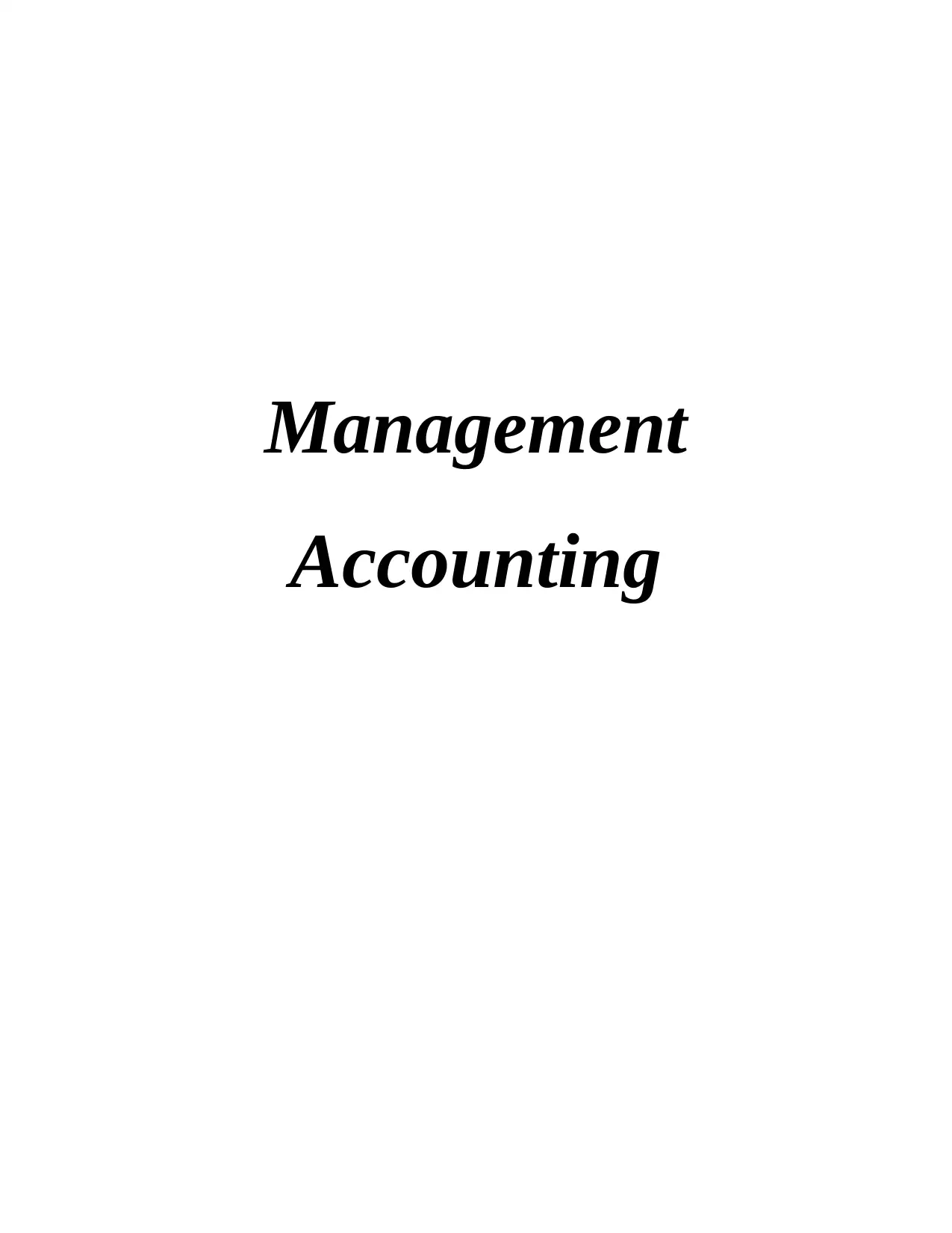
Management
Accounting
Accounting
Paraphrase This Document
Need a fresh take? Get an instant paraphrase of this document with our AI Paraphraser
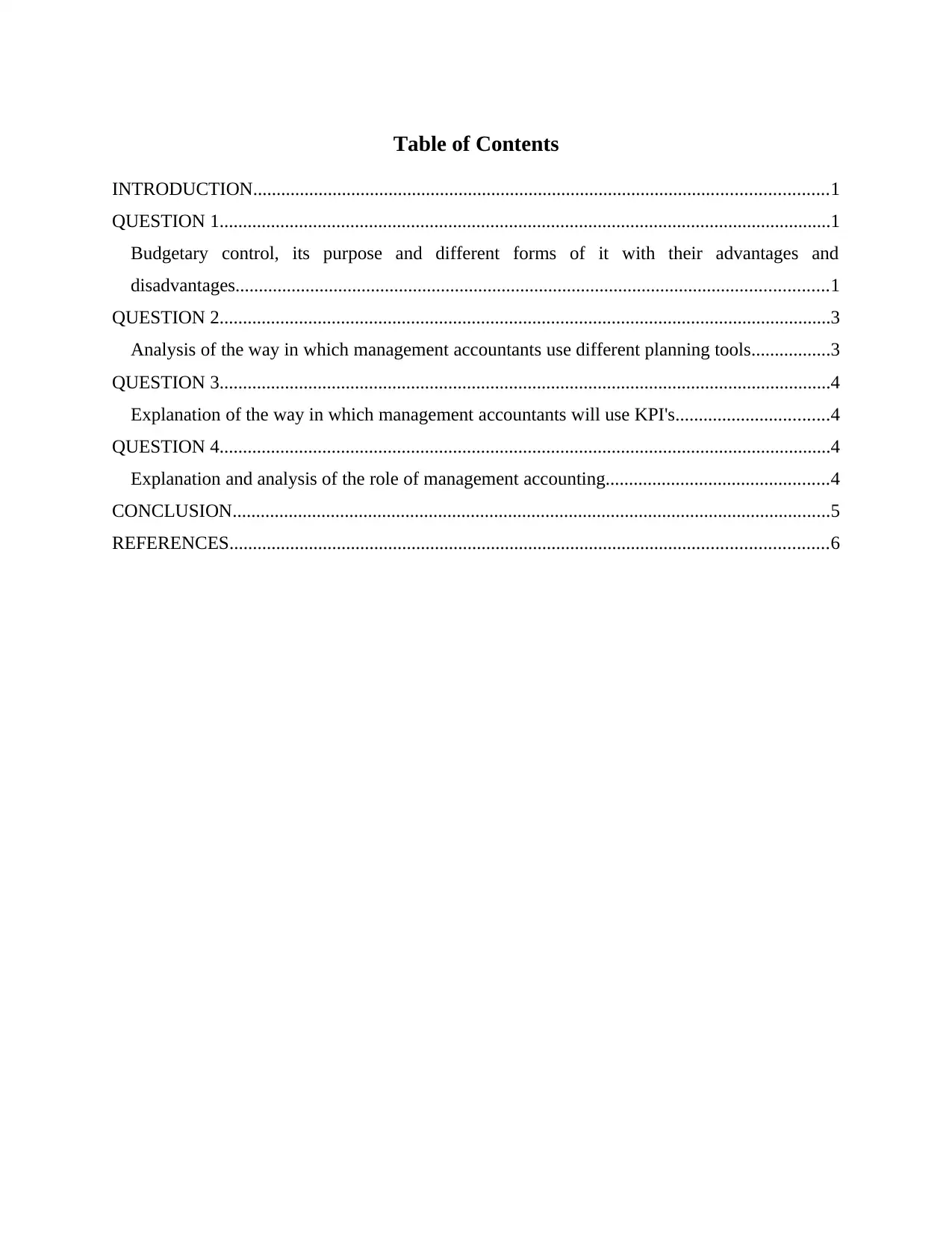
Table of Contents
INTRODUCTION...........................................................................................................................1
QUESTION 1...................................................................................................................................1
Budgetary control, its purpose and different forms of it with their advantages and
disadvantages...............................................................................................................................1
QUESTION 2...................................................................................................................................3
Analysis of the way in which management accountants use different planning tools.................3
QUESTION 3...................................................................................................................................4
Explanation of the way in which management accountants will use KPI's.................................4
QUESTION 4...................................................................................................................................4
Explanation and analysis of the role of management accounting................................................4
CONCLUSION................................................................................................................................5
REFERENCES................................................................................................................................6
INTRODUCTION...........................................................................................................................1
QUESTION 1...................................................................................................................................1
Budgetary control, its purpose and different forms of it with their advantages and
disadvantages...............................................................................................................................1
QUESTION 2...................................................................................................................................3
Analysis of the way in which management accountants use different planning tools.................3
QUESTION 3...................................................................................................................................4
Explanation of the way in which management accountants will use KPI's.................................4
QUESTION 4...................................................................................................................................4
Explanation and analysis of the role of management accounting................................................4
CONCLUSION................................................................................................................................5
REFERENCES................................................................................................................................6
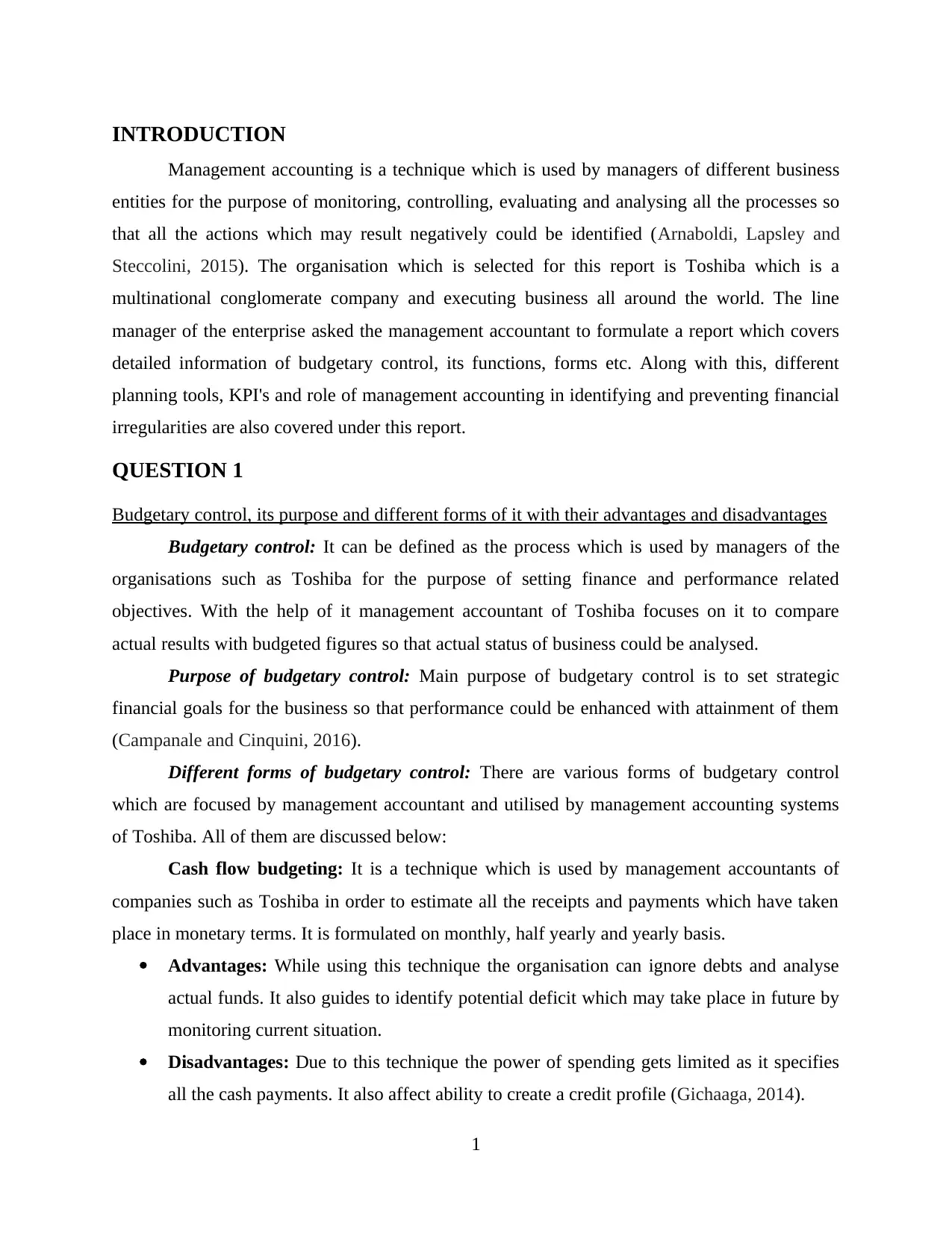
INTRODUCTION
Management accounting is a technique which is used by managers of different business
entities for the purpose of monitoring, controlling, evaluating and analysing all the processes so
that all the actions which may result negatively could be identified (Arnaboldi, Lapsley and
Steccolini, 2015). The organisation which is selected for this report is Toshiba which is a
multinational conglomerate company and executing business all around the world. The line
manager of the enterprise asked the management accountant to formulate a report which covers
detailed information of budgetary control, its functions, forms etc. Along with this, different
planning tools, KPI's and role of management accounting in identifying and preventing financial
irregularities are also covered under this report.
QUESTION 1
Budgetary control, its purpose and different forms of it with their advantages and disadvantages
Budgetary control: It can be defined as the process which is used by managers of the
organisations such as Toshiba for the purpose of setting finance and performance related
objectives. With the help of it management accountant of Toshiba focuses on it to compare
actual results with budgeted figures so that actual status of business could be analysed.
Purpose of budgetary control: Main purpose of budgetary control is to set strategic
financial goals for the business so that performance could be enhanced with attainment of them
(Campanale and Cinquini, 2016).
Different forms of budgetary control: There are various forms of budgetary control
which are focused by management accountant and utilised by management accounting systems
of Toshiba. All of them are discussed below:
Cash flow budgeting: It is a technique which is used by management accountants of
companies such as Toshiba in order to estimate all the receipts and payments which have taken
place in monetary terms. It is formulated on monthly, half yearly and yearly basis.
Advantages: While using this technique the organisation can ignore debts and analyse
actual funds. It also guides to identify potential deficit which may take place in future by
monitoring current situation.
Disadvantages: Due to this technique the power of spending gets limited as it specifies
all the cash payments. It also affect ability to create a credit profile (Gichaaga, 2014).
1
Management accounting is a technique which is used by managers of different business
entities for the purpose of monitoring, controlling, evaluating and analysing all the processes so
that all the actions which may result negatively could be identified (Arnaboldi, Lapsley and
Steccolini, 2015). The organisation which is selected for this report is Toshiba which is a
multinational conglomerate company and executing business all around the world. The line
manager of the enterprise asked the management accountant to formulate a report which covers
detailed information of budgetary control, its functions, forms etc. Along with this, different
planning tools, KPI's and role of management accounting in identifying and preventing financial
irregularities are also covered under this report.
QUESTION 1
Budgetary control, its purpose and different forms of it with their advantages and disadvantages
Budgetary control: It can be defined as the process which is used by managers of the
organisations such as Toshiba for the purpose of setting finance and performance related
objectives. With the help of it management accountant of Toshiba focuses on it to compare
actual results with budgeted figures so that actual status of business could be analysed.
Purpose of budgetary control: Main purpose of budgetary control is to set strategic
financial goals for the business so that performance could be enhanced with attainment of them
(Campanale and Cinquini, 2016).
Different forms of budgetary control: There are various forms of budgetary control
which are focused by management accountant and utilised by management accounting systems
of Toshiba. All of them are discussed below:
Cash flow budgeting: It is a technique which is used by management accountants of
companies such as Toshiba in order to estimate all the receipts and payments which have taken
place in monetary terms. It is formulated on monthly, half yearly and yearly basis.
Advantages: While using this technique the organisation can ignore debts and analyse
actual funds. It also guides to identify potential deficit which may take place in future by
monitoring current situation.
Disadvantages: Due to this technique the power of spending gets limited as it specifies
all the cash payments. It also affect ability to create a credit profile (Gichaaga, 2014).
1
⊘ This is a preview!⊘
Do you want full access?
Subscribe today to unlock all pages.

Trusted by 1+ million students worldwide
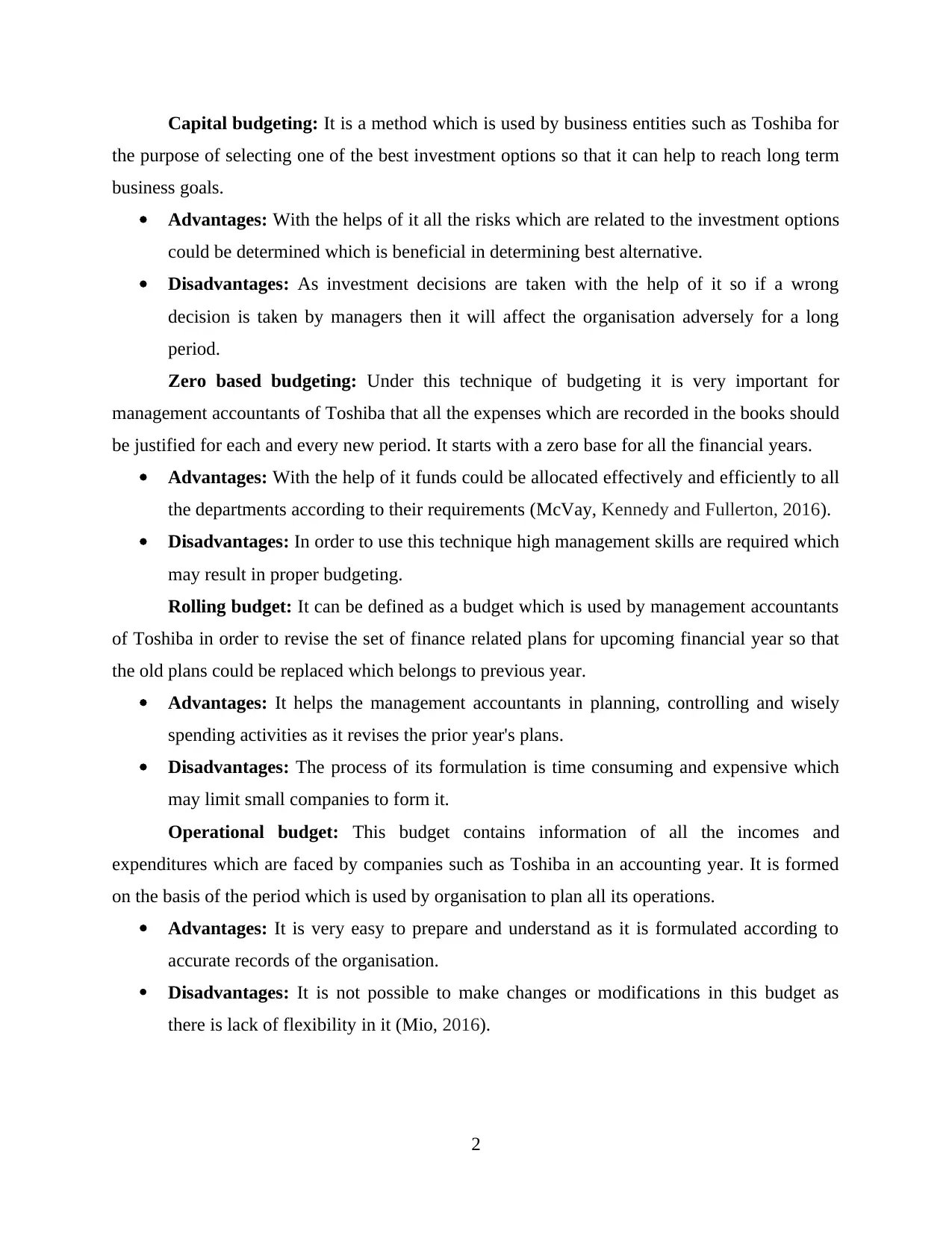
Capital budgeting: It is a method which is used by business entities such as Toshiba for
the purpose of selecting one of the best investment options so that it can help to reach long term
business goals.
Advantages: With the helps of it all the risks which are related to the investment options
could be determined which is beneficial in determining best alternative.
Disadvantages: As investment decisions are taken with the help of it so if a wrong
decision is taken by managers then it will affect the organisation adversely for a long
period.
Zero based budgeting: Under this technique of budgeting it is very important for
management accountants of Toshiba that all the expenses which are recorded in the books should
be justified for each and every new period. It starts with a zero base for all the financial years.
Advantages: With the help of it funds could be allocated effectively and efficiently to all
the departments according to their requirements (McVay, Kennedy and Fullerton, 2016).
Disadvantages: In order to use this technique high management skills are required which
may result in proper budgeting.
Rolling budget: It can be defined as a budget which is used by management accountants
of Toshiba in order to revise the set of finance related plans for upcoming financial year so that
the old plans could be replaced which belongs to previous year.
Advantages: It helps the management accountants in planning, controlling and wisely
spending activities as it revises the prior year's plans.
Disadvantages: The process of its formulation is time consuming and expensive which
may limit small companies to form it.
Operational budget: This budget contains information of all the incomes and
expenditures which are faced by companies such as Toshiba in an accounting year. It is formed
on the basis of the period which is used by organisation to plan all its operations.
Advantages: It is very easy to prepare and understand as it is formulated according to
accurate records of the organisation.
Disadvantages: It is not possible to make changes or modifications in this budget as
there is lack of flexibility in it (Mio, 2016).
2
the purpose of selecting one of the best investment options so that it can help to reach long term
business goals.
Advantages: With the helps of it all the risks which are related to the investment options
could be determined which is beneficial in determining best alternative.
Disadvantages: As investment decisions are taken with the help of it so if a wrong
decision is taken by managers then it will affect the organisation adversely for a long
period.
Zero based budgeting: Under this technique of budgeting it is very important for
management accountants of Toshiba that all the expenses which are recorded in the books should
be justified for each and every new period. It starts with a zero base for all the financial years.
Advantages: With the help of it funds could be allocated effectively and efficiently to all
the departments according to their requirements (McVay, Kennedy and Fullerton, 2016).
Disadvantages: In order to use this technique high management skills are required which
may result in proper budgeting.
Rolling budget: It can be defined as a budget which is used by management accountants
of Toshiba in order to revise the set of finance related plans for upcoming financial year so that
the old plans could be replaced which belongs to previous year.
Advantages: It helps the management accountants in planning, controlling and wisely
spending activities as it revises the prior year's plans.
Disadvantages: The process of its formulation is time consuming and expensive which
may limit small companies to form it.
Operational budget: This budget contains information of all the incomes and
expenditures which are faced by companies such as Toshiba in an accounting year. It is formed
on the basis of the period which is used by organisation to plan all its operations.
Advantages: It is very easy to prepare and understand as it is formulated according to
accurate records of the organisation.
Disadvantages: It is not possible to make changes or modifications in this budget as
there is lack of flexibility in it (Mio, 2016).
2
Paraphrase This Document
Need a fresh take? Get an instant paraphrase of this document with our AI Paraphraser
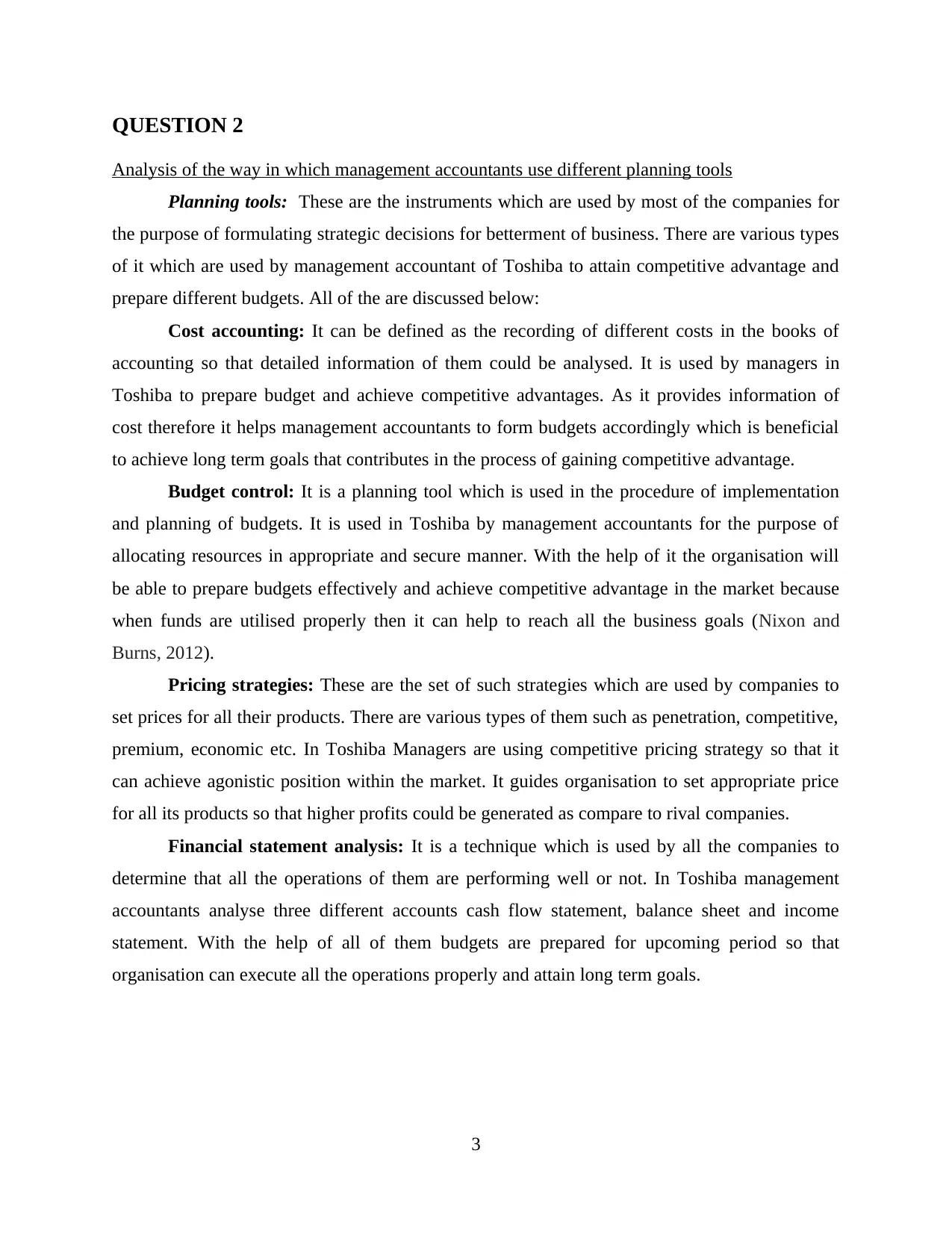
QUESTION 2
Analysis of the way in which management accountants use different planning tools
Planning tools: These are the instruments which are used by most of the companies for
the purpose of formulating strategic decisions for betterment of business. There are various types
of it which are used by management accountant of Toshiba to attain competitive advantage and
prepare different budgets. All of the are discussed below:
Cost accounting: It can be defined as the recording of different costs in the books of
accounting so that detailed information of them could be analysed. It is used by managers in
Toshiba to prepare budget and achieve competitive advantages. As it provides information of
cost therefore it helps management accountants to form budgets accordingly which is beneficial
to achieve long term goals that contributes in the process of gaining competitive advantage.
Budget control: It is a planning tool which is used in the procedure of implementation
and planning of budgets. It is used in Toshiba by management accountants for the purpose of
allocating resources in appropriate and secure manner. With the help of it the organisation will
be able to prepare budgets effectively and achieve competitive advantage in the market because
when funds are utilised properly then it can help to reach all the business goals (Nixon and
Burns, 2012).
Pricing strategies: These are the set of such strategies which are used by companies to
set prices for all their products. There are various types of them such as penetration, competitive,
premium, economic etc. In Toshiba Managers are using competitive pricing strategy so that it
can achieve agonistic position within the market. It guides organisation to set appropriate price
for all its products so that higher profits could be generated as compare to rival companies.
Financial statement analysis: It is a technique which is used by all the companies to
determine that all the operations of them are performing well or not. In Toshiba management
accountants analyse three different accounts cash flow statement, balance sheet and income
statement. With the help of all of them budgets are prepared for upcoming period so that
organisation can execute all the operations properly and attain long term goals.
3
Analysis of the way in which management accountants use different planning tools
Planning tools: These are the instruments which are used by most of the companies for
the purpose of formulating strategic decisions for betterment of business. There are various types
of it which are used by management accountant of Toshiba to attain competitive advantage and
prepare different budgets. All of the are discussed below:
Cost accounting: It can be defined as the recording of different costs in the books of
accounting so that detailed information of them could be analysed. It is used by managers in
Toshiba to prepare budget and achieve competitive advantages. As it provides information of
cost therefore it helps management accountants to form budgets accordingly which is beneficial
to achieve long term goals that contributes in the process of gaining competitive advantage.
Budget control: It is a planning tool which is used in the procedure of implementation
and planning of budgets. It is used in Toshiba by management accountants for the purpose of
allocating resources in appropriate and secure manner. With the help of it the organisation will
be able to prepare budgets effectively and achieve competitive advantage in the market because
when funds are utilised properly then it can help to reach all the business goals (Nixon and
Burns, 2012).
Pricing strategies: These are the set of such strategies which are used by companies to
set prices for all their products. There are various types of them such as penetration, competitive,
premium, economic etc. In Toshiba Managers are using competitive pricing strategy so that it
can achieve agonistic position within the market. It guides organisation to set appropriate price
for all its products so that higher profits could be generated as compare to rival companies.
Financial statement analysis: It is a technique which is used by all the companies to
determine that all the operations of them are performing well or not. In Toshiba management
accountants analyse three different accounts cash flow statement, balance sheet and income
statement. With the help of all of them budgets are prepared for upcoming period so that
organisation can execute all the operations properly and attain long term goals.
3
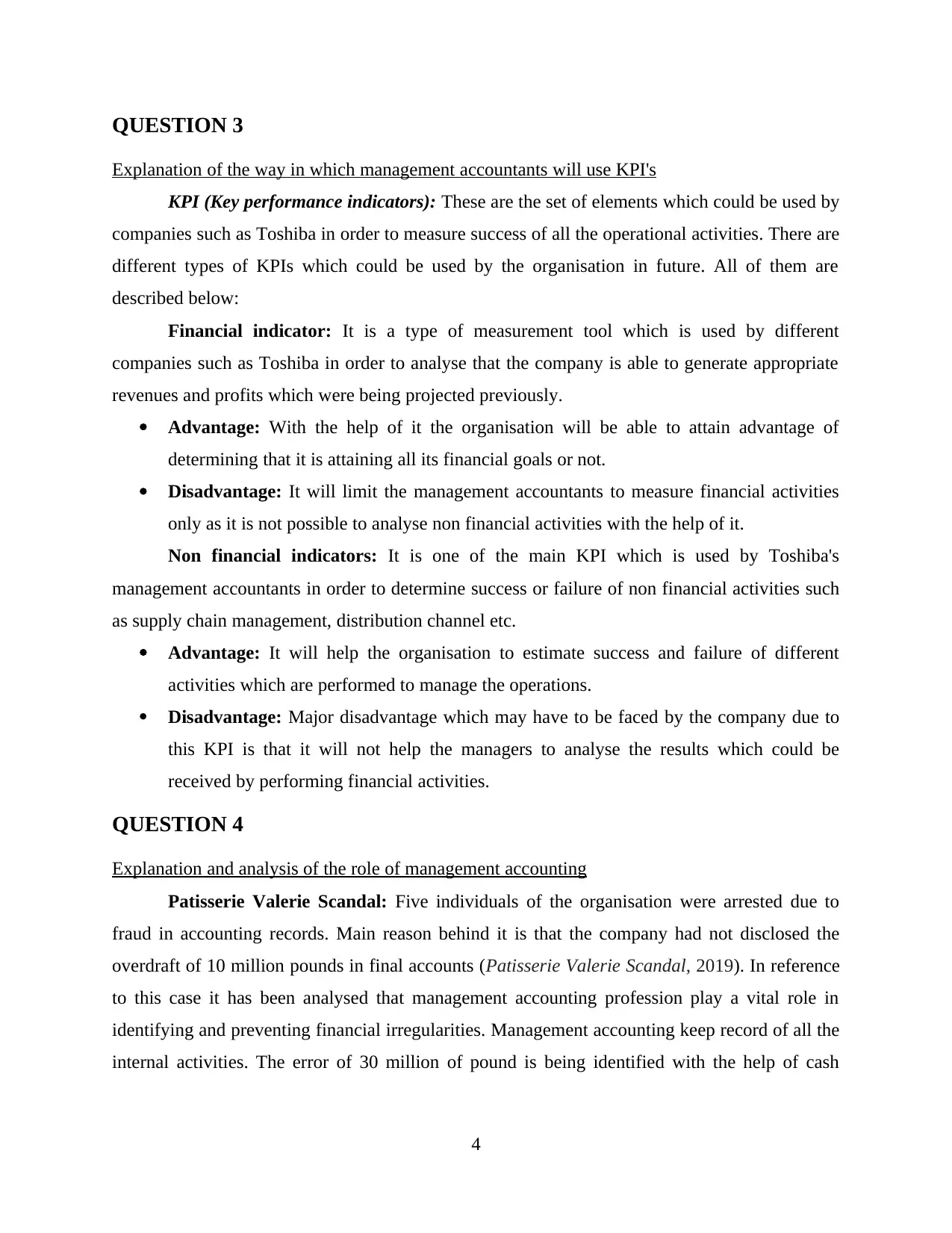
QUESTION 3
Explanation of the way in which management accountants will use KPI's
KPI (Key performance indicators): These are the set of elements which could be used by
companies such as Toshiba in order to measure success of all the operational activities. There are
different types of KPIs which could be used by the organisation in future. All of them are
described below:
Financial indicator: It is a type of measurement tool which is used by different
companies such as Toshiba in order to analyse that the company is able to generate appropriate
revenues and profits which were being projected previously.
Advantage: With the help of it the organisation will be able to attain advantage of
determining that it is attaining all its financial goals or not.
Disadvantage: It will limit the management accountants to measure financial activities
only as it is not possible to analyse non financial activities with the help of it.
Non financial indicators: It is one of the main KPI which is used by Toshiba's
management accountants in order to determine success or failure of non financial activities such
as supply chain management, distribution channel etc.
Advantage: It will help the organisation to estimate success and failure of different
activities which are performed to manage the operations.
Disadvantage: Major disadvantage which may have to be faced by the company due to
this KPI is that it will not help the managers to analyse the results which could be
received by performing financial activities.
QUESTION 4
Explanation and analysis of the role of management accounting
Patisserie Valerie Scandal: Five individuals of the organisation were arrested due to
fraud in accounting records. Main reason behind it is that the company had not disclosed the
overdraft of 10 million pounds in final accounts (Patisserie Valerie Scandal, 2019). In reference
to this case it has been analysed that management accounting profession play a vital role in
identifying and preventing financial irregularities. Management accounting keep record of all the
internal activities. The error of 30 million of pound is being identified with the help of cash
4
Explanation of the way in which management accountants will use KPI's
KPI (Key performance indicators): These are the set of elements which could be used by
companies such as Toshiba in order to measure success of all the operational activities. There are
different types of KPIs which could be used by the organisation in future. All of them are
described below:
Financial indicator: It is a type of measurement tool which is used by different
companies such as Toshiba in order to analyse that the company is able to generate appropriate
revenues and profits which were being projected previously.
Advantage: With the help of it the organisation will be able to attain advantage of
determining that it is attaining all its financial goals or not.
Disadvantage: It will limit the management accountants to measure financial activities
only as it is not possible to analyse non financial activities with the help of it.
Non financial indicators: It is one of the main KPI which is used by Toshiba's
management accountants in order to determine success or failure of non financial activities such
as supply chain management, distribution channel etc.
Advantage: It will help the organisation to estimate success and failure of different
activities which are performed to manage the operations.
Disadvantage: Major disadvantage which may have to be faced by the company due to
this KPI is that it will not help the managers to analyse the results which could be
received by performing financial activities.
QUESTION 4
Explanation and analysis of the role of management accounting
Patisserie Valerie Scandal: Five individuals of the organisation were arrested due to
fraud in accounting records. Main reason behind it is that the company had not disclosed the
overdraft of 10 million pounds in final accounts (Patisserie Valerie Scandal, 2019). In reference
to this case it has been analysed that management accounting profession play a vital role in
identifying and preventing financial irregularities. Management accounting keep record of all the
internal activities. The error of 30 million of pound is being identified with the help of cash
4
⊘ This is a preview!⊘
Do you want full access?
Subscribe today to unlock all pages.

Trusted by 1+ million students worldwide
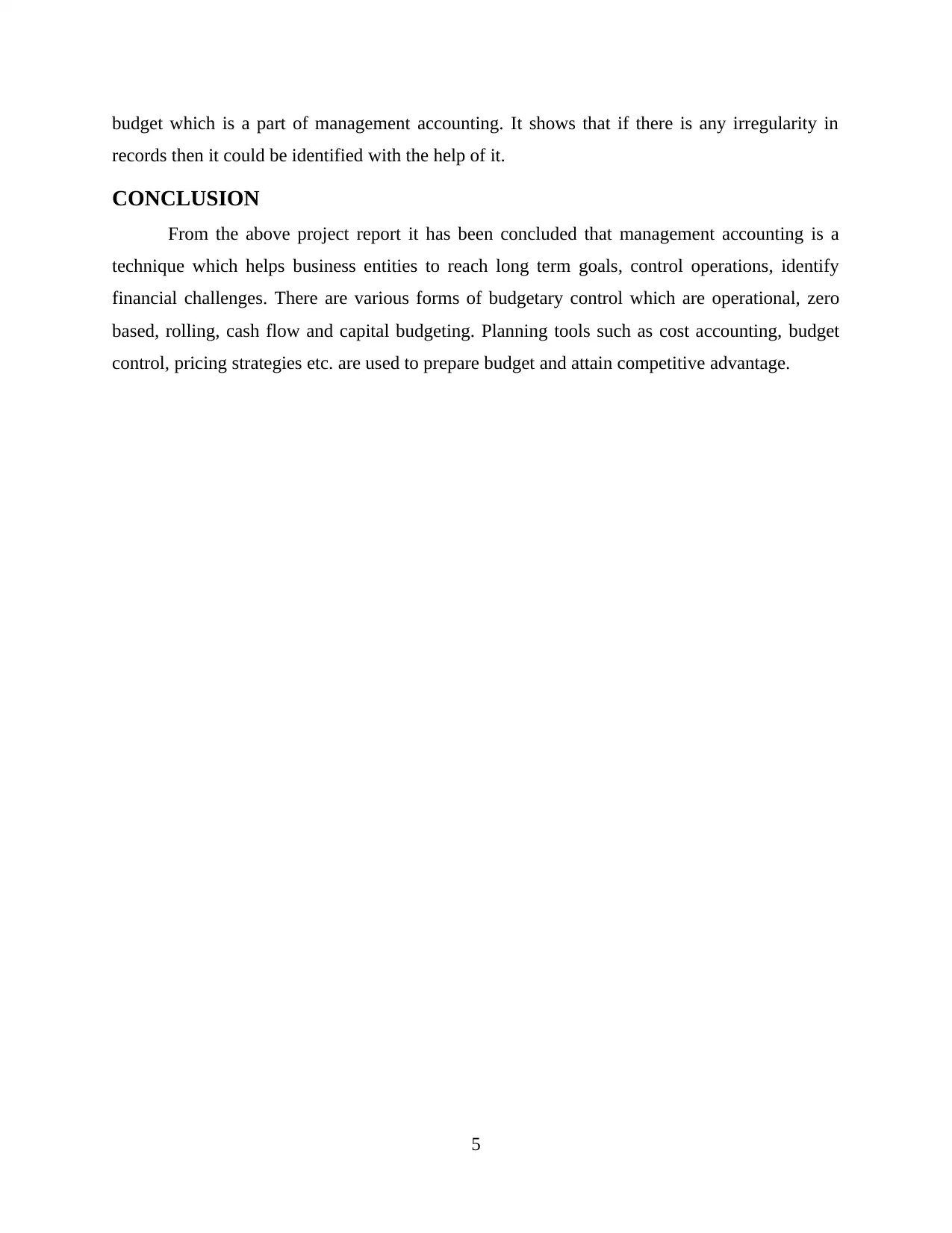
budget which is a part of management accounting. It shows that if there is any irregularity in
records then it could be identified with the help of it.
CONCLUSION
From the above project report it has been concluded that management accounting is a
technique which helps business entities to reach long term goals, control operations, identify
financial challenges. There are various forms of budgetary control which are operational, zero
based, rolling, cash flow and capital budgeting. Planning tools such as cost accounting, budget
control, pricing strategies etc. are used to prepare budget and attain competitive advantage.
5
records then it could be identified with the help of it.
CONCLUSION
From the above project report it has been concluded that management accounting is a
technique which helps business entities to reach long term goals, control operations, identify
financial challenges. There are various forms of budgetary control which are operational, zero
based, rolling, cash flow and capital budgeting. Planning tools such as cost accounting, budget
control, pricing strategies etc. are used to prepare budget and attain competitive advantage.
5
Paraphrase This Document
Need a fresh take? Get an instant paraphrase of this document with our AI Paraphraser
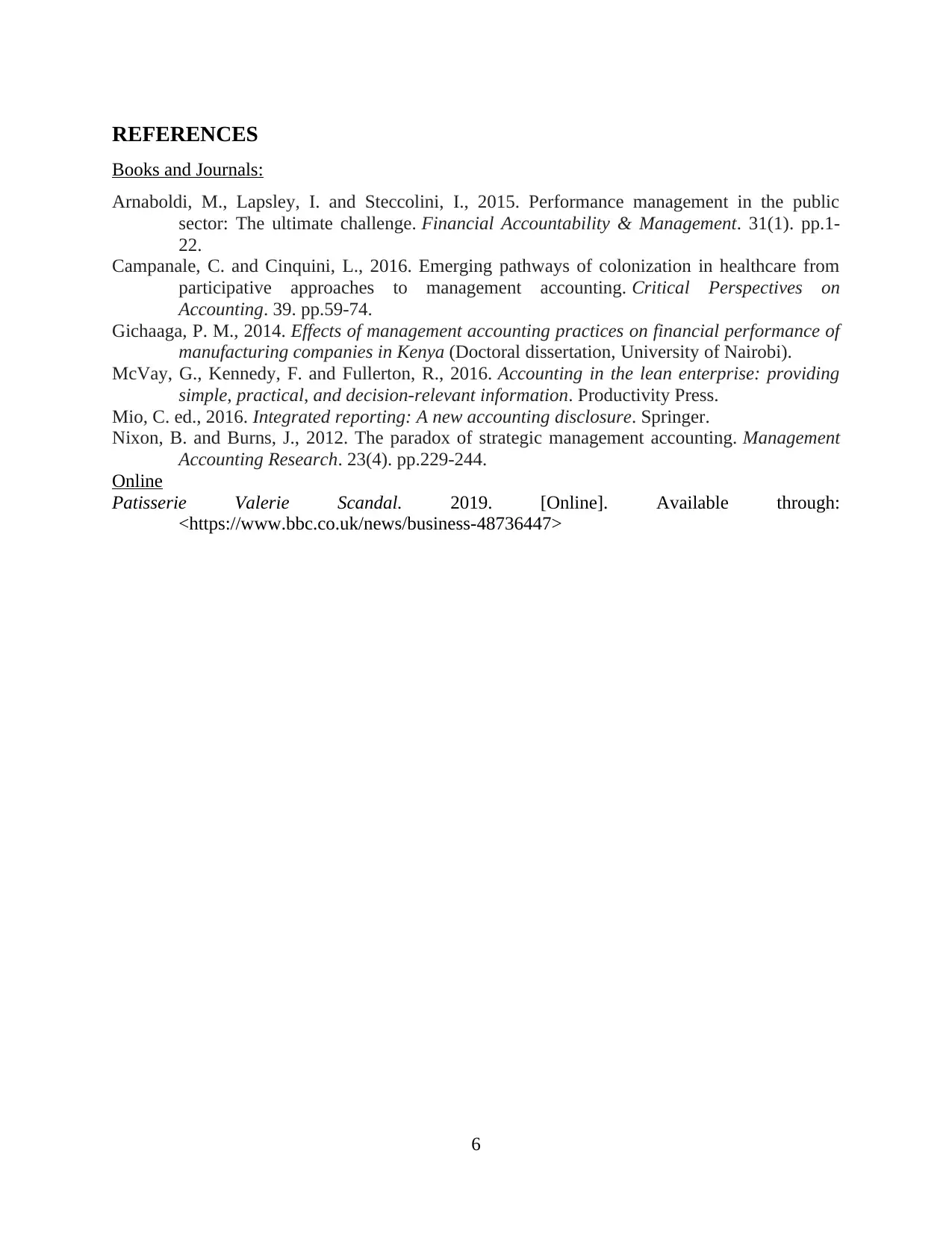
REFERENCES
Books and Journals:
Arnaboldi, M., Lapsley, I. and Steccolini, I., 2015. Performance management in the public
sector: The ultimate challenge. Financial Accountability & Management. 31(1). pp.1-
22.
Campanale, C. and Cinquini, L., 2016. Emerging pathways of colonization in healthcare from
participative approaches to management accounting. Critical Perspectives on
Accounting. 39. pp.59-74.
Gichaaga, P. M., 2014. Effects of management accounting practices on financial performance of
manufacturing companies in Kenya (Doctoral dissertation, University of Nairobi).
McVay, G., Kennedy, F. and Fullerton, R., 2016. Accounting in the lean enterprise: providing
simple, practical, and decision-relevant information. Productivity Press.
Mio, C. ed., 2016. Integrated reporting: A new accounting disclosure. Springer.
Nixon, B. and Burns, J., 2012. The paradox of strategic management accounting. Management
Accounting Research. 23(4). pp.229-244.
Online
Patisserie Valerie Scandal. 2019. [Online]. Available through:
<https://www.bbc.co.uk/news/business-48736447>
6
Books and Journals:
Arnaboldi, M., Lapsley, I. and Steccolini, I., 2015. Performance management in the public
sector: The ultimate challenge. Financial Accountability & Management. 31(1). pp.1-
22.
Campanale, C. and Cinquini, L., 2016. Emerging pathways of colonization in healthcare from
participative approaches to management accounting. Critical Perspectives on
Accounting. 39. pp.59-74.
Gichaaga, P. M., 2014. Effects of management accounting practices on financial performance of
manufacturing companies in Kenya (Doctoral dissertation, University of Nairobi).
McVay, G., Kennedy, F. and Fullerton, R., 2016. Accounting in the lean enterprise: providing
simple, practical, and decision-relevant information. Productivity Press.
Mio, C. ed., 2016. Integrated reporting: A new accounting disclosure. Springer.
Nixon, B. and Burns, J., 2012. The paradox of strategic management accounting. Management
Accounting Research. 23(4). pp.229-244.
Online
Patisserie Valerie Scandal. 2019. [Online]. Available through:
<https://www.bbc.co.uk/news/business-48736447>
6
1 out of 8
Related Documents
Your All-in-One AI-Powered Toolkit for Academic Success.
+13062052269
info@desklib.com
Available 24*7 on WhatsApp / Email
![[object Object]](/_next/static/media/star-bottom.7253800d.svg)
Unlock your academic potential
Copyright © 2020–2025 A2Z Services. All Rights Reserved. Developed and managed by ZUCOL.





